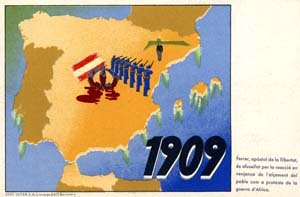1909
Ferrer, apòstal de la llibertat, és afusellat per la reacció en venjança de l'alçament del poble com a protesta de la guerra d'Africa.
Ferrer, apóstal de la libertad, es fusilado por la reacción producida en venganza del levantamiento del pueblo como protesta del la guerra de Africa.
Pour se venger de ce que le peuple s'est soulevé pour protester contre la guerre d'Afrique, Ferrer, apôtre de la liberté, est fusillé par la réaction.
Ferrer, apostolo de la libereco, estas pafmortigita dé la reakcio kiel vengo[sic] al la ribelo de la popolo proteste kontrau[sic] la Afrika milito.
Ferrer, apostle of liberty, is shot by the forces of reaction in revenge for the people's rising in protest against the African war.
The execution of Francesc Ferrer came at the end of the Tragic Week (Semana Trágica, or Setmana Tràgica in Catalan) that erupted in Catalonia from July 35 to August 2 of 1909. Motivated by a state of renewed colonial conquest in North Africa, the working classes of Barcelona and other neighboring cities, led by anarchist, communist, and republican political figures, rose in opposition to the government. The uprising was severely put down by the Spanish army. Under a state of martial law, Ferrer was executed without trial on October 13 at Montjuic fortress in Barcelona.
As a work of propaganda, this first postcard features several graphic designs that make recurrent appearances throughout the series. At the center, a bloodied crown is meant to represent the blame of the monarchy in the affair, an association reinforced by the red and yellow brushstrokes of the Alphonsine flag that appear to the left. On the right, a firing squad composed of faceless soldiers with their backs to the viewer take aim at Ferrer. Their placement and composition are reminiscent of the French soldiers shown executing Spanish patriots in Francisco Goya's The Third of May 1808. Behind Ferrer appears the silhouetted form of Montjuic fortress.

